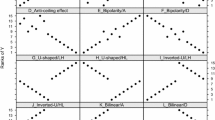Abstract
Concordance describes the agreement between m rankings of k objects. Despite the long history of measures of concordance and the recently revived interest in comparison of concordance (c.f. Legendre in J Agric Biol Environ Stat 10(2):226–245, 2005), the task of visualising concordance remained virtually unaddressed. We first show how to depict concordance by simply plotting raw data in parallel coordinates. Then we review further possibilities for depicting concordance using the recently developed plots of inter-rater variability in ordinal ratings (Nelson and Pepe in Stat Methods Med Res 9:475–496, 2000) and plots of correlation matrices (Trosset in J Comput Graph Stat 14(1):1–19, 2005). Next, we propose two novel concordance plots. The concordance bubble-plot is based on raw rank data, while the pin-cushion plot depicts rank differences in polar coordinates. We present visualisations of artificial and real-life datasets with different degree of concordance and identify strong and weak points of the proposed plots. In conclusion, we review some other work related to visualisation of concordance and discuss some other options for constructing novel concordance plots.
Similar content being viewed by others
References
Baggerly KA (1995) Visual estimation of structure in ranked data. Ph.D. Thesis, Rice University, Houston
Beckett J, Schucany WR (1975) ANACONDA: Analysis of concordance of g groups of judges. In: Proceedings of Social Statistics Section of the American Statistical Association, pp 311–313
Beckett J, Schucany WR (1979) Concordance among categorized groups of judges. J Edu Stat 4(2):125–137
Cleveland WS (1994) The elements of graphing data. Hobart Press, Summit
Cleveland WS, McGill R (1984) Graphical perception: theory, experimentation, and application to the development of graphical methods. J Am Stat Assoc 79(387):531–554
Corsten LCA, Gabriel KR (1976) Graphical exploration in comparing variance matrices. Biometrics 32:851–863
Ehrenberg ASC (1952) Onsampling from a population of rankers. Biometrika 39:82–87
Gescheider GA (1985) Psychophysics: method, theory, and application, 2nd edn. Lawrence Erlbaum, Hillsdale
Holm S (1979) A simple sequentially rejective multiple test procedure. Scand J Stat 6:65–70
Iman RL, Conover WJ (1987) A measure of top-down correlation. Technometrics 29(3):351–357
Inselberg A (1985) Plane with parallel coordinates. Vis Comput 1:69–97
Kendall M, Babington Smith B (1939) The problem of m rankings. Ann Math Stat 10:275–287
Legendre P (2005) Species associations: the Kendall coefficient of concordance revisited. J Agric Biol Environ Stat 10(2):226–245
Legendre P, Lapointe F-J (2004) Assessing congruence among distance matrices: single-malt scotch whiskies revised. Aust N Z J Stat 46(4):615–629
Lockhead GR (1992) Psychophysical scaling: judgment of attributes or objects? Behav Brain Sci 15:543–558
Lockhead GR (1995) Psychophysical scaling methods reveal and measure context effects. Behav Brain Sci 18:607–612
Lyerly SB (1952) The average Spearman rank correlation coefficient. Pychometrika 17:421–428
Nelson JC, Pepe MS (2000) Statistical description of interrater variability in ordinal ratings. Stat Methods Med Res 9:475–496
Page EB (1963) Ordered hypotheses for multiple treatments: a significance test for linear ranks. J Am Stat Assoc 58:216–230
Palachek AD, Schucany WR (1984) On approximate confidence intervals for measures of concordance. Psychometrika 49(1):133–141
R Development Core Team (2004) R: a Language and environment for statistical computing. R Foundation for Statistical Computing, Vienna, Austria. ISBN 3-900051-00-3, http://www.r-project.org
Schucany WR, Frawley WH (1973) A rank test for two group concordance. Psychometrika 38(2):249–258
Seber GAF (1984) Multivariate observations. Wiley, New York
Siegel S, Castellan J (1988) Nonparametric statistics for the behavioral sciences, 2nd edn. McGraw-Hill, New York
Thompson GL (1994) Visualising frequency distributions of ranked data. Comput Stat 9(1):1–10
Trosset MW (2005) Visualizing correlation. J Comput Graph Stat 14(1):1–19
Tufte ER (1998) The visual display of quantitative information, 16th printing. Graphics Press, Chesire
Vidmar G, Cernigoj M (2004) Studying norms in small groups by means of multi-group concordance analysis. Horiz Psychol 13(4):55–66
Wainer H, Thissen D (1981) Graphical data analysis. Ann Rev Psychol 32:191–241
Wilkie D (1980) Pictorial representation of Kendall’s rank correlation coefficient. Teach Stat 2:76–78
Author information
Authors and Affiliations
Corresponding author
Rights and permissions
About this article
Cite this article
Vidmar, G., Rode, N. Visualising concordance. Computational Statistics 22, 499–509 (2007). https://doi.org/10.1007/s00180-007-0057-9
Published:
Issue Date:
DOI: https://doi.org/10.1007/s00180-007-0057-9




